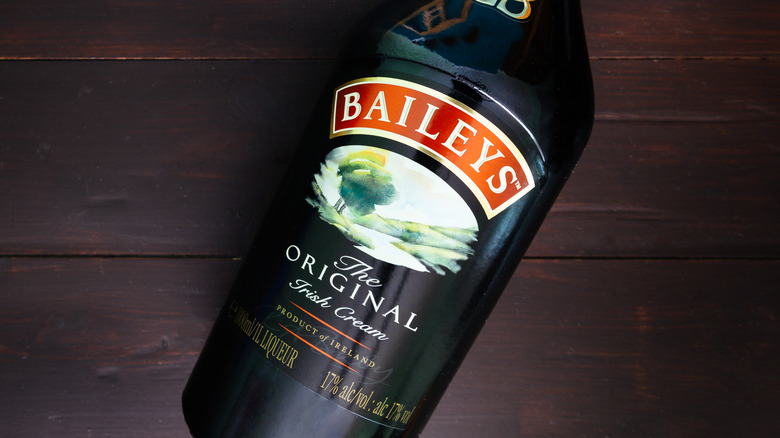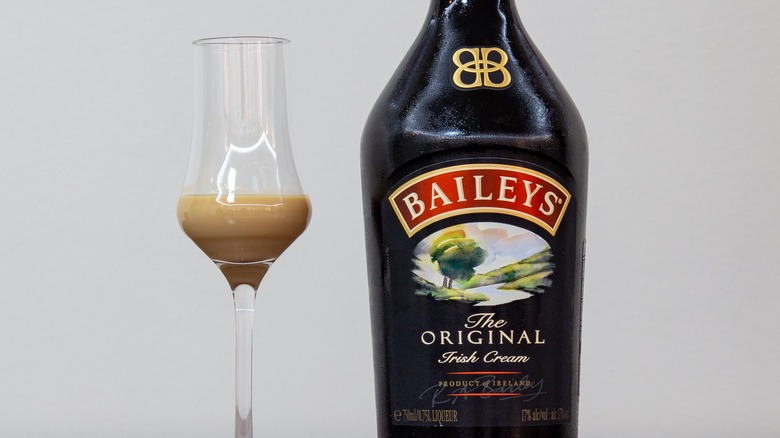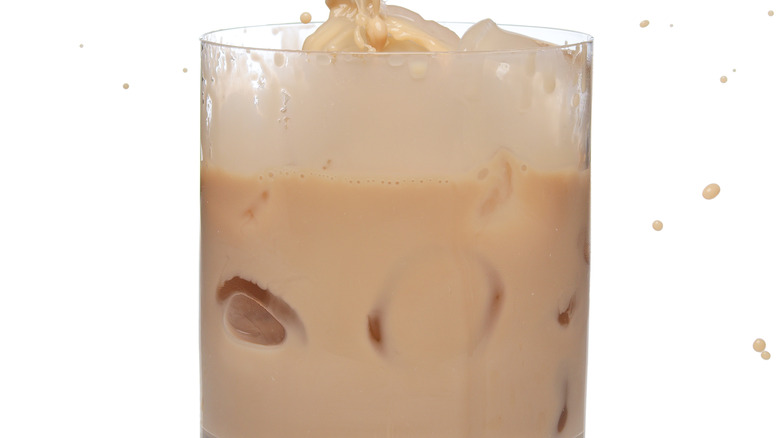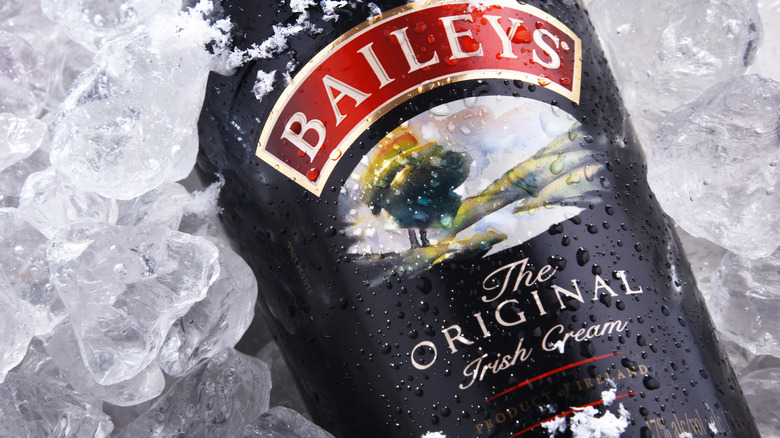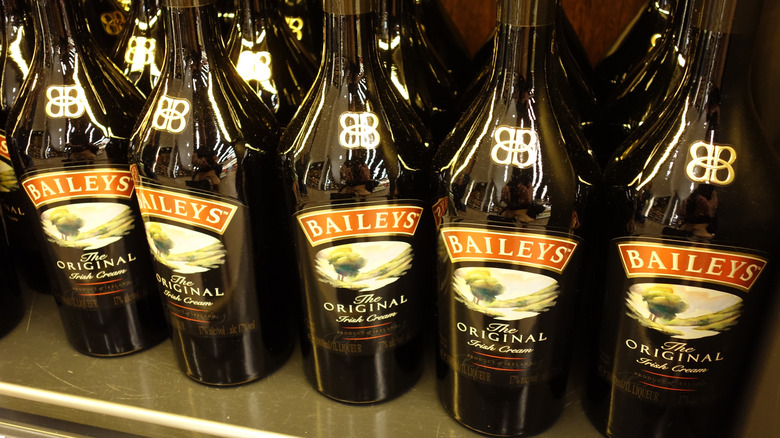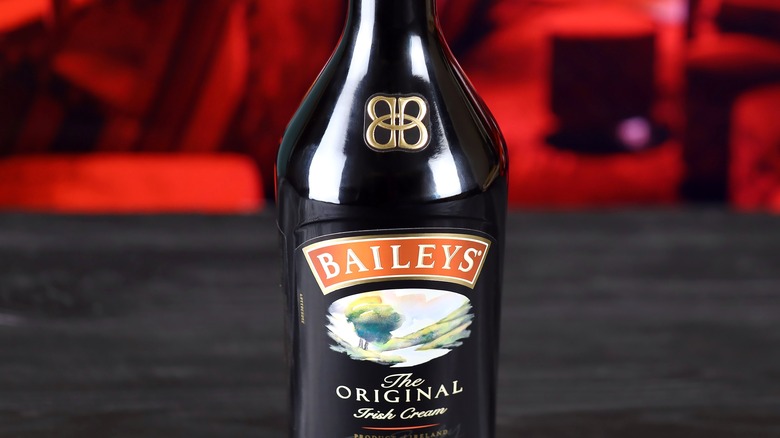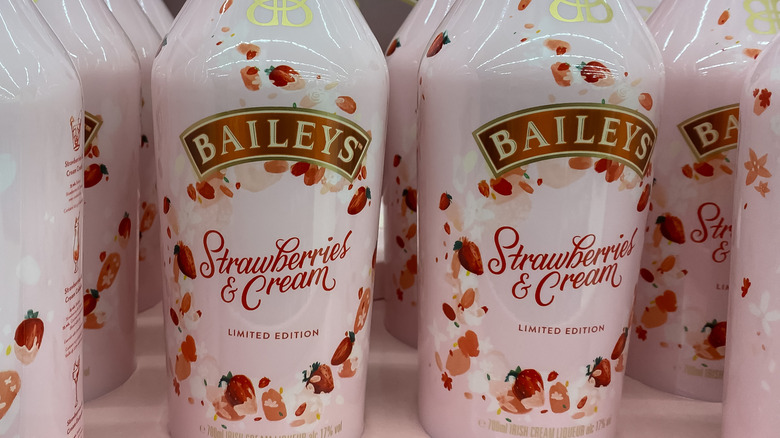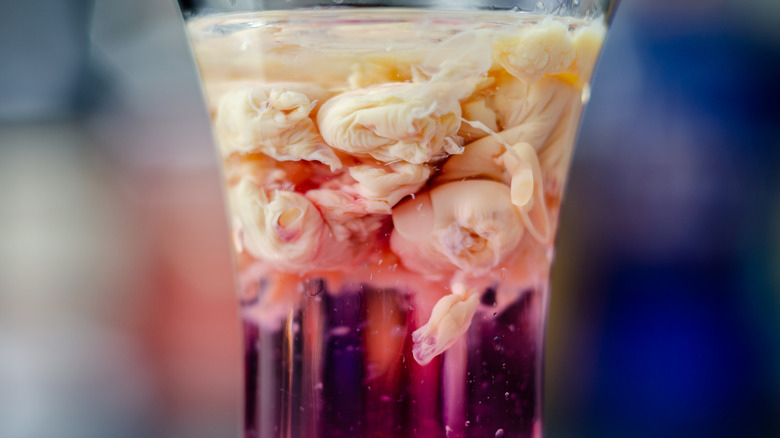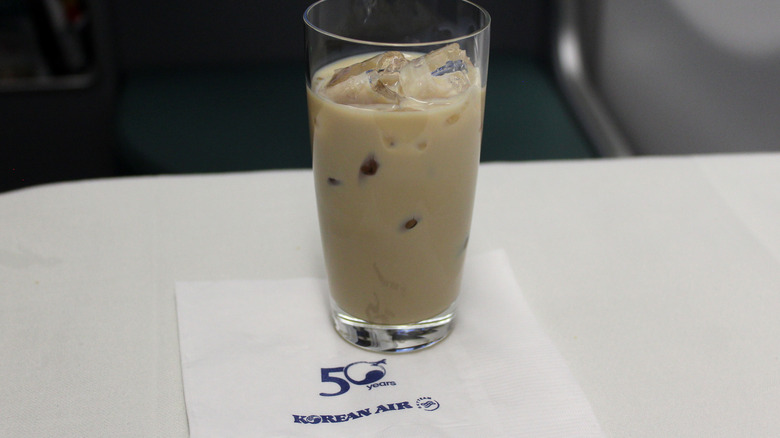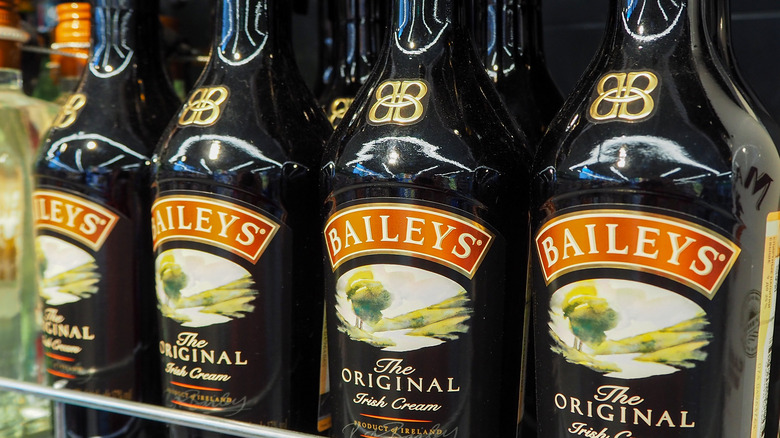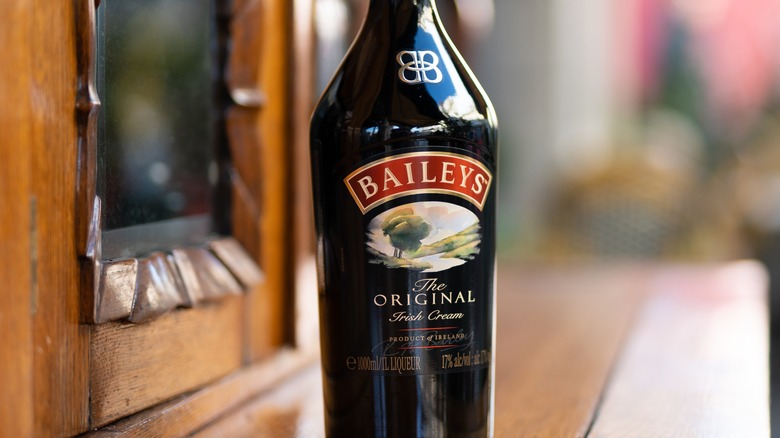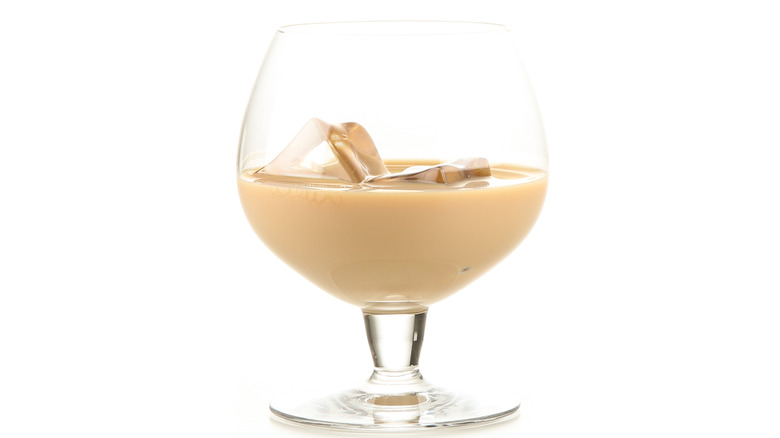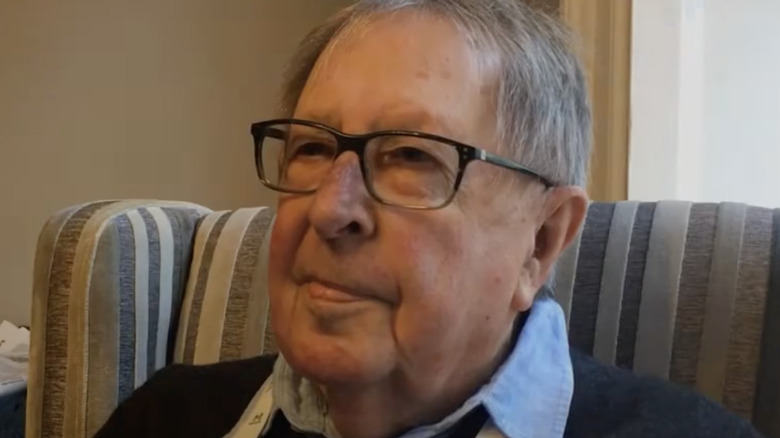12 Facts About Baileys Irish Cream
Baileys Irish Cream has always been one of the more mellow choices on the adult drinks menu. A stalwart in bars and restaurants that's both consumed in mass quantities and given as a gift at countless holiday parties, this classic liqueur is smooth and creamy while also sweet and savory in addition to giving a slight alcoholic kick. That's because it's a combination of but a few simple ingredients: semi-heavy cream, authentic Irish whiskey, sugar, and a hint of chocolate. It's a simple recipe, and much the same as manufacturers have used since Baileys was created in the early 1970s.
Not just the brand most synonymous with Irish cream, Baileys was the first drink to bear that name, launching a big market sector of easy-to-drink liqueurs like Saint Brendan's, Carolans, and Kerrygold, among others. But five decades after it introduced itself to the world, Baileys remains one of the bestselling liqueurs of any kind on the planet — in 2020, parent company Diageo sold its 2 billionth bottle of the stuff (via The Spirits Business).
Here, then, is a long, smooth, slightly sweet, and easy-to-savor pour on the creation, history, legacy, and impact of Baileys Irish Cream.
Baileys began as a business challenge
A product so definitively Irish that the designation is right there in the name, Baileys Irish Cream was first mixed up in a London office by two men, one from England and the other from South Africa. According to ThinkBusiness, marketing business partners Hugh Reade Seymour-Davies (of England) and David Gluckman (who emigrated from South Africa in the 1960s) were trying to meet the call from alcohol distributor International Distillers and Vintners (IDV) referred to as the "Irish brief": to design and develop a new, Irish-identifying branded drinks line that could be exported around the world.
IDV's internal research-and-development department had come up with a few ideas, mostly traditional but run-of-the-mill liqueurs made from honey and heather, according to The Irish Times. But other than the requirement to make the product somehow "Irish," IDV had provided Seymour-Davies and Gluckman with only one guideline — to use as little real Irish whiskey as possible, because the distributor didn't have any business arrangements set up with distilleries in Ireland at that point, so the supply that would contribute to any new beverage would be limited or inconsistent.
It took some trial and error to get the Baileys recipe right
Before he landed the gig to come up with an Irish-themed export product for International Distillers and Vintners, according to The Irish Times, David Gluckman had helped launch Kerrygold, the line of premium Irish butter, cheese, and other dairy products, in the 1960s. Thinking about his success with Kerrygold made Gluckman think of the marketing imagery associated with that brand — cows and pastures. He wondered aloud to partner Hugh Reade Seymour-Davies if there was something from that world which could be used on an alcoholic product.
Seconds later, Gluckman recalled, Seymour-Davies blurted out, "What would happen if we mixed Irish whiskey and cream?" They immediately went to International Stores, the closest grocery store to their office in London, and purchased a bottle of Jameson Irish Whiskey and a tub of single cream (which, according to Nigella Lawson, is a thick dairy product widely available in the U.K. with a consistency and fat content similar to that of half and half). The pair returned to their office and simply mixed them and tasted the results. "It was certainly intriguing, but in reality it was bloody awful," Gluckman said.
A little sugar improved the homemade concoction, but what really made the difference was the addition of some Cadbury's Powdered Drinking Chocolate, acquired via a second grocery store trip. That was what was missing, and that's more or less the recipe still used to make Baileys 50 years later.
How Baileys got its name
After the liqueur was fully formulated, David Gluckman and Hugh Reade Seymour-Davies needed a name for their product before they and International Distillers and Vintners could get the drink ready for production and distribution. According to The Irish Times, Gluckman thought back a decade earlier to his Kerrygold days when Tony O'Reilly — once the wealthiest man in Ireland, a newspaper tycoon, Heinz executive, and the credited creator of Kerrygold — told him, as Gluckman put it, "Irish names sound quaint when applied to brands." In his colleague's honor, Gluckman considered going with the name O'Reilly's Irish Cream, before deciding that an "Anglo-Irish" family name of some kind would be good, as many drink brands were frequently named after people, often their creators (for example: Jim Beam, Jack Daniel's, and Johnnie Walker).
Gluckman and Seymour-Davies took inspiration when they were scouting new office space in London's Soho area. On Greek Street, they spotted a place for rent near a general cuisine restaurant called Baileys Bistro. It was suitably Irish-sounding to Gluckman, while it also conjured up a childhood memory of Baileys Dairy in South Africa. He floated the name to Seymour-Davies, and "Baileys Irish Cream" was christened.
The origin of the distinctive Baileys bottle
The outside of each bottle of Baileys is decorated with a lot of words and imagery suggesting the drink's supposedly old and idyllic Irish origins. Much of that is marketing, whimsical inventions of David Gluckman and Hugh Reade Seymour-Davies, according to The Irish Times.
When it entered mass production, Baileys would be manufactured and bottled in Ireland and made with real Irish whiskey. But in the early 1970s, when it existed only as an idea, Gluckman and Seymour-Davies had to fudge the product's origins and placed on the label the proclamation that Baileys was created in The Dairy Distillery in County Monaghan. "It was a complete fabrication of mine," Gluckman admitted — the address wasn't at all real. It reminded him of a previous product he'd helped develop, Kerrygold butter, which was similarly made in Ireland and came in packaging depicting Irish farms. Those images inspired Gluckman to ask his graphic designer to make a Baileys label featuring cows grazing and beautiful pastures.
One final flourish was needed on the label — a signature to hammer home the notion that Baileys was the creation of a person by that name. Gluckman saw a headline about a golf tournament operated by The Royal and Ancient Golf Club of St Andrews, abbreviated as "R&A." The creators took those initials to make up the fictional brothers R & A Bailey.
Baileys' test marketing went poorly
Before meeting with their bosses at International Distillers and Vintners, Baileys creators David Gluckman and Hugh Reade Seymour-Davies wanted to do some customer research to make sure the product was as good as they thought it was — if people would actually buy it in the real world. According to The Irish Times, the duo's approach was two-pronged: They conducted a couple of focus group sessions and also arranged to have two Baileys bottles prominently placed in the Allsop Arms, a pub near Gluckman's home. The focus group results weren't encouraging. One respondent likened the taste to morphine, while another respondent, a man, said he didn't want to drink something so "girly."
Gluckman dutifully visited the Allsop Arms' publican on multiple nights for sales reports ... and heard that nobody had touched the stuff. But one evening, Gluckman went to the Allsop Arms and noticed that one of the two bottles had disappeared. According to the bartender, two police officers came into the pub that afternoon and drank the entire thing. That tiny bit of evidence, actually anecdotal evidence, was enough proof for Gluckman and Seymour-Davies that Baileys could succeed.
There are a lot of Baileys offshoots
Baileys is a valuable and lucrative product for alcohol consortium Diageo, but the name brand is highly recognizable and capable of supporting numerous brand extensions. The original Baileys Irish Cream blend was a simple one of whiskey, cream, and a little chocolate, and switching out some flavoring agents for others resulted in a vast product line of sweet, milky, boozy liqueurs bearing the Baileys name and packaging imagery. As of 2023, Baileys produces 12 distinct varieties and flavors including Salted Caramel, Espresso Crème, Red Velvet, Apple Pie, Chocolate Cherry, Colada, S'mores, and Strawberries & Cream. In 2017, the company introduced its first dairy-free item in Almande (via FoodBev Media), which is almond-flavored and almond milk-based. Deliciously Light, debuting in 2021, is a diet Baileys drink with both 40% less sugar and 40% fewer calories than standard Baileys.
Other attempts to expand the brand haven't been as successful. In 2005, according to Marketing Week, Diageo discontinued Baileys Glide after less than two years on shelves. The ready-to-drink item came bottled in individual serving sizes and was basically Baileys Irish Cream but with less alcohol.
Baileys is an ingredient in a lot of novelty cocktails
Some like to drink their alcohol straight up, while others prefer it combined with mixers and presented as a composed cocktail. Liqueurs, already combinations of alcohol and taste-enhancing agents, are well suited to be the basis for cocktails, and Baileys Irish Cream is such a specific and unique blend of strong whiskey, velvety cream, sweet sugar, and flavorful chocolate that it's been used as the launching point for numerous oddly named or adventurous cocktails or shooters.
There's the Brain Hemorrhage, in which the Baileys is poured into a shot of peach schnapps, at which point the cream curdles and comes to resemble brain matter floating in blood-red liquid. Curdling is also at work in a Cement Mixer. It's a cocktail made inside the drinker: They hold a shot of Baileys in their mouth and then squeeze half a lime or lemon into the liquid. A little swirling around causes the citrus juice to curdle the cream in the Baileys. You may have heard of the Bl** Job, a mixed shot with a name we can't fully print that delights the eyes with its layering effect — amaretto on the bottom, Baileys in the middle, and whipped cream on top. The Drain Pipe looks like what its name says it is, because the ingredients combine to form a foaming glass of green goo — it's equal parts Baileys, blue Curaçao, and cola.
An airline was sued over Baileys
Baileys isn't commonly available only in bars, liquor stores, and restaurants. It's a part of the air travel routine for many, sold in airport duty-free shops and served in tiny bottles on planes. Its presence is mighty in air travel, and in November 2017, the liqueur was the source of a severe accident. According to The Independent, Andreas Wuchner was in London's Heathrow Airport and about to board a flight to Zurich via British Airways. While checking in at the BA desk, he slipped in a puddle of Baileys left by a bottle accidentally broken by another traveler, hit his head, and suffered what doctors diagnosed as a traumatic brain injury.
Wuchner sued British Airways, which denied allegations of criminal negligence. Wuchner ultimately won the suit, owing to a clause in an international treaty called the Montreal Convention. It provides financial damages for anyone who endures an injury in the process of international air travel, and a judge ruled that Wuchner was entitled to a payout of £130,000 (about $161,000).
Baileys is shelf stable
Conventional wisdom would hold that something consisting largely of a dairy product would require constant refrigeration and would need to be consumed in a relatively short window of time before spoilage naturally sets in. But Baileys Original Irish Cream is formulated in such a way that it has an extremely long shelf life and doesn't easily go bad. According to the manufacturer's website, a glass bottle of Baileys Original is safe and palatable for two years from the date of bottling. Provided that it's stored at a company-recommended temperature between 32 and 77 degrees Fahrenheit, the product inside is fine. It doesn't even have to be refrigerated, not even after it's been opened.
The only exceptions to this rule are Baileys products that come in plastic bottles, which reduces the shelf life to a still-robust 18 months. Certain flavors of Baileys also don't last quite as long as Baileys Original, chilled or not, including Apple Pie (18 months), Deliciously Light (18 months), and Strawberries & Cream (20 months).
Improperly discarded Baileys can cause significant plumbing problems
While it can survive in a cupboard for up to two years, a lot of people don't know that about Baileys Irish Cream, and they dispose of what's left in the bottles after the occasion for which it was purchased. According to Glasgow World, it's a popular Christmas and winter holiday treat in the United Kingdom, but not so much in the weeks immediately after those celebrations end. The result: A lot of Britons pour whatever Baileys is left in the bottles down their drains, where it enters public water systems. In January 2023, major U.K. water company Southern Water publicly pleaded with its customers to refrain from dumping their unwanted creamy liqueurs down the drain because it can cause significant blockages. "Something like Baileys, which has a cream content could add to problems," head of Southern Water's wastewater divisions Alex Saunders noted. "No one likes a nasty surprise over the festive season and a blocked drain is no different."
British industrial cleaning service Rentokil Specialist Hygiene weighed in, too, echoing the statements of Southern Water. "Flushing unsuitable products down domestic or commercial drains can lead to expensive drain blockages and overflowing sinks as well as increasing the risk of contamination," technical and innovations manager Jamie Woodhall told The Mirror, "since grease sludge can harbor pathogenic bacteria."
Baileys has geographic protected status
A very small number of foods and beverages are so associated with their point of origin, and are so important to their respective local economies, that their authenticity must be fiercely protected. According to ScienceDirect, this led to laws on the books in European Union nations and the United Kingdom called "Protected Designation of Origin" and "Protected Geographical Indications." This means that only foods certified as what they say they are can be sold under that name. Examples include Bordeaux wines from the Bordeaux region of France, Champagne from the Champagne area of France, many traditional hams and cheeses, and Irish cream, particularly Baileys Irish Cream.
Under Irish law, passed in 2008, three alcoholic drinks, Irish whiskey, Irish cream, and Irish poitín, can be labeled and sold as such only if they originated in Ireland. Baileys, the first Irish cream, falls under the purview of those regulations. It's both produced and bottled only in Ireland.
The co-creator of Baileys is a booze legend
Baileys was an early and resounding success for businessperson and drinks creator David Gluckman, who helped invent the industry standard in Irish cream in the early 1970s. It also launched a prolific career in the spirits industry, as Gluckman went on to help create and bring to the market multiple very famous alcohol brands and styles. Right after concocting Baileys, Gluckman helped make wine into a mainstream, middle-class beverage in the U.K. by launching the concept of name-brand vino in that country with Le Piat d'Or, according to the London School of Economics. Gluckman similarly made wine more populist with Le Piat d'Or in Japan and Canada.
Gluckman further innovated in other sectors of the alcohol market (via The Daily Mail), with a hand in the creation of Diddy's grape-based Ciroc Vodka, Smirnoff Black, and Tanqueray No. 10 gin. He even went back to his Baileys-esque roots. In 2008, according to Ireland's Independent, he was part of the team that developed Coole Swan, a new kind of cream liqueur that in 2020 received a perfect 100 score from Wine Enthusiast.
